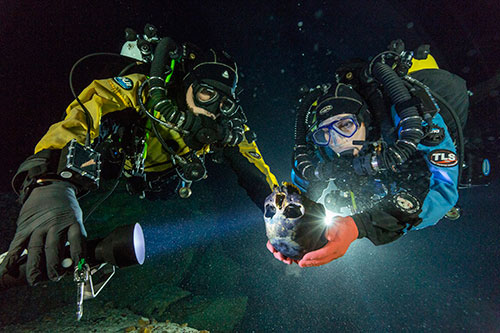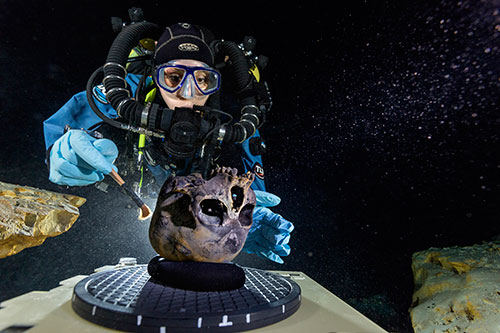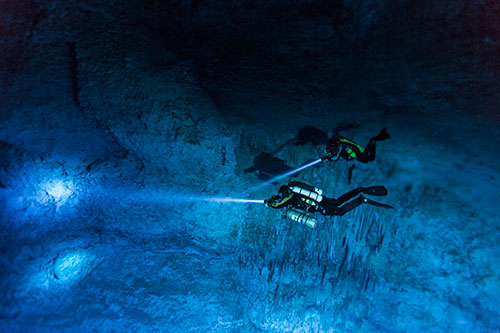
One of oldest human skeletons in North America is discoveredRemains of 12,000- to 13,000-Year-Old Teenage Girl Found in Underwater Mexican Cave Establish Definitive Link Between Earliest Americans and Modern Native Americans
May 20, 2014
Deciphering the ancestry of the first people to populate the Americas has been a challenge. On the basis of genetics, modern Native Americans are thought to descend from Siberians who moved into eastern Beringia (the landmass connecting Asia and North America) between 26,000 and 18,000 years ago. These people, the earliest Americans, then spread southward.
Divers Alberto Nava and Susan Bird transport the Hoyo Negro skull to an underwater turntable so that it can be photographed in order to create a 3-D model.
"Modern Native Americans closely resemble people of China, Korea, and Japan," James Chatters, lead author on the study, said, "but the oldest American skeletons do not." They have longer, narrower crania than later Native Americans, and smaller, shorter faces, too -- more closely resembling modern peoples of Africa, Australia, and the Southern Pacific Rim. "This has led to speculation that perhaps the first Americans and Native Americans came from different homelands," Chatters continued, "or migrated from Asia at different stages in their evolution." Complicating the puzzle, it's been very difficult to find intact Paleoamerican skeletons for study. "Paleoamerican skeletons are rare for several reasons," Chatters explained. "The people themselves were few; they were highly nomadic and seem to have buried or cremated the dead where they fell, making the locations of graves unpredictable; also, geologic processes have destroyed or deeply buried their graves." Meanwhile, those skeletal remains that have been unearthed are lacking, often only fragments, and most estimated to be younger than 10,000 years old. (The earliest Americans reached the continent farther back in time than that.) Now, however, Chatters and colleagues report the discovery of a near-complete Late Pleistocene-age human skeleton. It was hidden deep in a submerged chamber in the Sac Actun cave system on Mexico's Eastern Yucatán Peninsula. "Hoyo Negro is a more than 100-foot-deep, bell-shaped, water-filled void about the size of a professional basketball arena deep inside a drowned cave system," Chatters said. "Only technical cave divers can reach the bottom. First they must climb down a 30-foot ladder in a nearby sinkhole; then they swim along 200 feet of tunnel to the pit rim before making a final 100-foot drop. The divers are the astronauts of this project; we scientists are their mission control." Like nearby caves, Hoyo Negro was accessible only via sinkhole; people and animals fell in and were trapped. Then, starting about 10,000 years ago, global glaciers melted, filling the caves with water. In addition to the near-complete human skeleton, the researchers found the remains of 26 large mammals, including extinct taxa such as sabertooths and gomphotheres. The nearly-intact skeleton was that of a small human female about 15 or 16 years old. Based on radiocarbon dating of tooth enamel and analyses of mineral deposits on her bones, the researchers inferred her remains to be at least 12,000 years old.
Diver Susan Bird brushes the human skull found at the underwater Hoyo Negro site while her team members take detailed photographs. He and colleagues analyzed the girl's mitochondrial DNA (mtDNA), a useful tool for examining the relatedness of populations. Their analysis revealed a haplotype common to modern Native Americans, subhaplogroup D1. This genetic signature occurs only in the Americas, likely having developed in Beringia after populations there split from other Asians. The sample shows that individuals of the Pleistocene era with Beringian-derived mtDNA traveled far and wide through the Americas, all the way down to Mexico, for example. Critically, it shows that despite differences in craniofacial form, this early American woman was related to modern Native Americans; the differences in craniofacial form are probably best explained as evolutionary changes that happened after the divergence of Beringians from their Siberian ancestors, the authors say. Their work suggests that America was not colonized by separate migration events from different parts of Eurasia. Rather, the earliest Americans represent an early population expansion out of Beringia. This aligns with the hypothesis that both Paleoamericans and Native Americans derive from a single source population. Chatters and colleagues were delighted with their find: "This project is exciting on so many fronts: the beautiful cave, the incredibly well-preserved animal skeletons, the completeness of the human skeleton, the success of our innovative dating approach. But for me," he said, "what is most exciting is that we finally have an answer, after 20 years, to a question that has plagued me since my first look at Kennewick Man: 'Who were the first Americans?'"
Divers search the walls of Hoyo Negro, an underwater cave on Mexico's Yucatan Peninsula where the remains of a 13,000- to 12,000-year-old teenage girl were found. The skeletal remains of a teenage female from the late Pleistocene or last ice age found in an underwater cave in Mexico have major implications for our understanding of the origins of the Western Hemisphere’s first people and their relationship to contemporary Native Americans. “These discoveries are extremely significant,” said Pilar Luna, INAH’s director of underwater archaeology. “Not only do they shed light on the origins of modern Americans, they clearly demonstrate the paleontological potential of the Yucatán Peninsula and the importance of conserving Mexico’s unique heritage.” The findings detailed in Science this month are noteworthy on numerous levels:
The field research team endured extremely challenging conditions to access the skeleton’s remote underwater location at the bottom of Hoyo Negro, deep beneath the jungles of the eastern Yucatán Peninsula. The multidisciplinary team, composed of professional divers, archaeologists and paleontologists, extensively documented the bones in situ. Alberto Nava with Bay Area Underwater Explorers was part of the team that first discovered Hoyo Negro in 2007. “We had no idea what we might find when we initially entered the cave, which is the allure of cave diving,” said Nava. “Needless to say, I am incredibly proud to be part of the efforts to share Hoyo Negro’s story with the world.” Funding for the project was provided by the Archaeological Institute of America, the Waitt Institute, The University of New Mexico, The Pennsylvania State University, The University of Texas at Austin, University of Illinois at Urbana-Champaign, DirectAMS and supported by the National Geographic Society. Researchers from McMaster University, Northwestern University and Washington State University also participated. The Hoyo Negro expedition will be featured in National Geographic magazine and on a National Geographic Television program airing on the PBS series “NOVA” in 2015.
Source of News:
|
||


